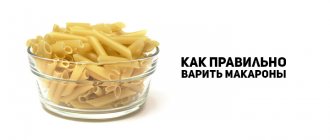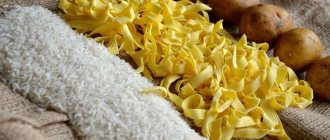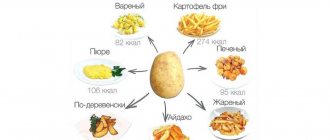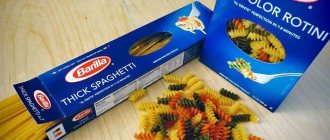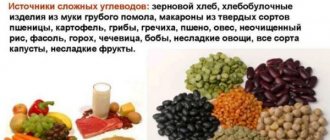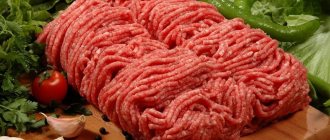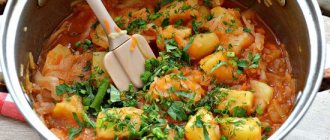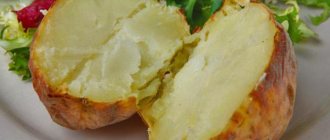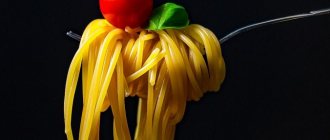April 21 Carbohydrates are an important part of a complete diet. Which products are their best source can be debated at the level of national cuisines. Let's try to look at this issue from the perspective of Italy versus Russia, or, to put it simply, pasta versus potatoes.
Carbohydrates, depending on the rate of absorption, are divided into fast and slow. Fast carbohydrates are all sweets: glucose, fructose, sucrose. They cause a rise in blood sugar and insulin and quickly turn into fats. Slow carbohydrates (starches), found in pasta ,
potatoes , cereals , bread ,
do not create sugar spikes and are the highest quality and correct “fuel” for us. But besides the carbohydrates in pasta and potatoes, there are other variables that affect the body in one way or another. Therefore, we will weigh the pros and cons.
Health benefit or harm?
In addition, pasta contains vitamin E (tocopherol) - the most well-known antioxidant that prevents cell destruction, it protects them from damage, slows down the aging process, and prevents the appearance of wrinkles. Those who regularly consume pasta do not have to worry about cardiovascular diseases: complex carbohydrates lower blood cholesterol levels. And a large amount of fiber improves intestinal function.
In addition to potassium, potatoes are rich in other minerals - calcium, magnesium, phosphorus, iron. As well as vitamin C, an antioxidant that takes part in all redox processes in the body, one medium-sized potato contains about half the recommended daily intake (although half of it is destroyed during heat treatment). We also get a large amount of protein from potatoes (about 2.1% of the original weight of fresh potatoes) and beta-carotene (provitamin A).
Conclusion:
Pasta wins in terms of vitamin E content, but, unlike potatoes, it does not contain vitamin C at all. If we evaluate how many nutrients we get per serving (200 g) of one and another product, potatoes come out on top
. It has a higher saturation of minerals and vitamins.
Contraindications and risks associated with them
In addition to the benefits, it is also worth highlighting cases when potatoes and pasta are of little use in practice and can lead to the opposite effect.
Solanine , which is contained in potato peels, can provoke severe poisoning of the human body. Vegetables that have been stored for a long time under abundant sunlight are especially dangerous.
Those people who do not tolerate wheat components well should avoid pasta . Difficulties with the gastrointestinal tract also prevent us from enjoying this flour dish. And those who recently had to undergo a difficult surgical procedure will have to forget about pasta dishes for a while.
What won't harm your figure?
Potatoes or pasta? The answer is simple - both! Those who are losing weight should not be afraid of these products. Starches, combined with proteins and fiber, provide a long-lasting feeling of fullness. It's all about the quantity and time of consumption. Since these are carbohydrates, they are best eaten for breakfast or lunch.
The amino acid tryptophan found in pasta
, not only lifts your mood, but also regulates your appetite. Fiber, an indigestible carbohydrate of plant origin, helps cleanse the body. It is not digested or absorbed, unlike light carbohydrates and starch. Its volume irritates the intestines and accelerates peristalsis, reducing the absorption of fats, carbohydrates and proteins. Serves as nutrition for intestinal microflora. Absorbs heavy metal salts and bile acids. Yes, dry pasta contains about 330 kcal per 100 g, this figure is often scary, but many do not take into account that boiled pasta contains about 100 kcal and about 28.2 g of carbohydrates per 100 grams of the finished dish.
Conclusion:
When considering these products in the context of benefits for the figure, it is wrong to say that any of them is better. It's a sure draw here.
It all depends on how long the heat treatment of the products takes place. During long cooking, starch is hydrolyzed and complex carbohydrates are converted into simple ones. This is why al dente pasta, cooked until half cooked, is much healthier than overcooked pasta. And steamed or boiled potatoes are much healthier than those that simmer for hours on the stove or in the oven.
Pasta, rice and potatoes help you lose weight, scientists say
Not all carbohydrates are equally harmful for weight loss, scientists say. Those who want to lose weight, as a rule, exclude starch and sugar from the diet, as they quickly turn into glucose, which causes insulin levels in the body to rise, and this, in turn, inhibits fat burning. However, studies of the so-called resistant starch prove that it not only does not interfere with, but also promotes weight loss, since it contains fiber and many nutrients.
Resistant starch is not digested in the small intestine, but when it enters the large intestine, it nourishes the flora and promotes the production of short fatty acids that stabilize blood sugar levels. In addition, the fiber it contains cleanses the body.
As several studies conducted in recent decades have shown, such starch improves heart health and digestion, and prevents the development of gastrointestinal diseases. All these studies were brought together by the British Nutrition Foundation, which responsibly states: fiber, which is contained, including in starch, must be taken on average 30 grams per day to reduce the risk of a number of chronic diseases.
The Spanish newspaper La Vanguardia offers a list of products that contain resistant starch in its natural form.
Oatmeal and rice
. The best way to prepare oatmeal to maximize the benefits of resistant starch is to cook it and refrigerate it for a few days. Or make “lazy oatmeal”: soak it in water or kefir and also leave it to brew. It is also better to cook rice a week in advance, the main thing is to make sure that it does not rot or dry out.
Potato
. Regular potatoes or sweet potatoes should be cooked, then cooled and reheated. This technique is believed to work with other carbohydrate foods as well.
Pasta
. They are also useful for weight loss. They too should be cooled and reheated after cooking rather than eaten straight away, according to research from the British Foundation.
Vegetables and legumes
. This food has long been known for its richness in fiber, but it also contains no less resistant starch: for every 100 grams of vegetables there are 3-4 grams of the beneficial substance. For maximum benefit, they should be eaten ripe and hot.
Green bananas
. They are also rich in fiber and resistant starch, as well as vitamins C and B6. It's best to buy them while they're green, but keep them at home for a few more days before eating them.
Subtleties of gastronomy
We examined the products under ideal conditions: welded, without adding any other components. Indeed, both pasta and potatoes have many benefits for the body. But everything changes when they arrive: oil, fats, sauces!
Healthy:
pasta cooked until al dente. Served with vegetable sauce or vegetables, lean fish, seafood or skinless chicken breast.
You should not use:
pasta fried in vegetable oil after cooking, as well as in combination with meat, creamy sauces or seasoned with vegetable oil.
Healthy:
potatoes, boiled or baked with their skins on. If you cook potatoes without skins, some of the potassium goes into the broth; steamed potatoes; mashed potatoes with water. Combine with vegetables, herbs, seafood, skinless chicken breast.
You should not use:
potatoes fried in vegetable oil in a frying pan. A combination of potatoes, including boiled ones, with heavy meat.
For reference:
Harmful!
French fries and chips. Frying fats used to fry these foods have an extremely negative impact on health. They lead to an excess of saturated fatty acids in the human diet, increasing the risk of heart and vascular diseases. Consumption of such products often leads to obesity. As a result of frying, various carcinogens are formed in foods. A large amount of salt retains excess fluid in the body and is a risk factor for hypertension.
Conclusion:
Despite all the benefits of these two products, if prepared incorrectly, they can be harmful to health. At this point, potatoes gain penalty points and give way to pasta.
It is loved and prepared precisely in those forms that “hit” health the hardest.
In what situations will potatoes become the most popular food?
Eating potatoes will benefit many of its consumers due to the unique composition of this vegetable . After all, eating it will help:
- Get essential amino acids for the body , as well as some fatty elements that provide satiety and comfort. All this leads to the fact that the human nervous system works in the required mode and without failures.
- Provide yourself with a sufficient amount of antioxidants aimed at maintaining the youthful appearance of your skin for as long as possible and improving the health of your blood vessels.
- Those suffering from stomach ulcers, as well as heart and kidney diseases, can be recommended to eat boiled potatoes .
- For people who experience frequent constipation, juice squeezed from these fruits will help normalize stool .
- If you have burns and bruises, it makes sense to use grated hot potatoes, recently boiled in a saucepan.
- If the respiratory tract needs to be restored, you can use a kind of steam inhalation , inhaling the aroma emanating from the skin of a freshly boiled similar vegetable.
Communication information
The stereotype that pasta leads to excessive weight gain is very unfounded. To be convinced of this, just look at the Italians, who simply adore this type of food.
Despite the abundant starch content in potatoes, it is not without reason that this fruit is popularly called the second bread. Even fried potatoes cooked in sunflower oil can be used in your diet. But in order to add some variety to a similar dish, you need to know what exactly is best to serve it with. These can be a variety of pickles, salted or smoked fish, cheese, ketchup, mayonnaise and other table ingredients that are widely used in practice.
In some cases, you can even successfully combine pasta with potatoes, adding additional types of products. Thus, it is quite possible to get a high-calorie side dish and feed it to everyone!
Calorie content and dietary fat, glycemic index
The calorie content and nutritional value of these products depend on several factors: variety, method of preparation. Let's compare the calorie content of potatoes and rice and other indicators of nutritional value.
Different types of rice
There are red, brown (brown), wild (black) and white rice:
The energy and nutritional value of different types of rice is presented in the table.
| Type of rice | White | Brown | Red | Wild |
| Energy value, kcal | 360-370 | 337 | 362 | 101 |
| Proteins, g | 7 | 7 | 10,5 | 16 |
| Fats, g | 1 | 2 | 2,5 | 3 |
| Carbohydrates, g | 80 | 73 | 70,5 | 79 |
| Glycemic index | 85 | 55-60 | 55 | 45-50 |
Approximate daily diet
Breakfast
- Black coffee, tea or herbal tea in unlimited quantities, optionally with sweetener and 2 tbsp. spoons of skim milk (30 ml),
- 1 slice (30 g) bread and 2 level teaspoons (10 g) butter or margarine, or 2–3 tablespoons (30 g) sugar-free wholemeal breakfast cereal (less than 380 calories per 100 g) and 6 nuts (almonds, walnuts, cashews, etc.)
- 170g plain low-fat yoghurt with optional sweetener or equivalent protein product
- 1 fruit (140 g).
Lunch
Black coffee, tea or herbal tea in unlimited quantities, optionally with sweetener and 2 tbsp. spoons of skim milk (30 ml).
Dinner
- Raw vegetables or salad in unlimited quantities with 1 teaspoon of vegetable oil and unlimited amounts of lemon juice, vinegar, mustard, onions, herbs,
- 110 g lean meat, cooked without added fat, or equivalent protein product,
- vegetables, boiled or steamed without adding fat, in unlimited quantities,
- 170g plain low-fat yogurt, optionally sweetened, or equivalent protein product,
- 1 fruit (140 g).
Afternoon snack
Black coffee, tea or herbal tea in unlimited quantities, optionally with sweetener and 2 tbsp. spoons of skim milk (30 ml).
Dinner
- Unlimited raw vegetables or salad with 1 teaspoon oil and unlimited lemon juice, vinegar, mustard, onions, herbs, or vegetable soup (no more than 100 calories and 3.5 g fat per serving),
- 110 g lean meat, cooked without added fat, or equivalent protein product,
- 100 g carbohydrates (pasta, rice, potatoes) with 1 level teaspoon (7 g) butter or margarine,
- 30 g cheese (less than 50% fat) or equivalent protein product,
- vegetables, boiled or steamed without adding fat, in unlimited quantities,
- 1 fruit (140 g).
The information on the site is for reference only and does not constitute a recommendation for independent diagnosis and treatment. For medical questions, be sure to consult your doctor.
What are the benefits of potatoes?
Potatoes contain many fewer calories than pasta, and the low content of BJU (proteins, fats, carbohydrates) adds benefits to potatoes. This product is excellent for people with stomach and intestinal diseases. It is much healthier to boil potatoes, bake them, or stew them, rather than fry them with oil, which contains harmful fats and carcinogens. At the same time, potatoes significantly lose ground in their beneficial properties.
Potatoes, like pasta, are rich in vitamins and amino acids. Young potatoes are much healthier due to their low starch content. The longer potatoes are stored, the less beneficial properties and elements they contain. Therefore, you should not lean too heavily on it, especially during the period from the end of winter to the beginning of spring, when old potatoes have already lost their properties, and new ones have not yet appeared in markets or supermarkets.
Potatoes are strictly contraindicated for overweight people, especially when fried, as they lead to a number of diseases - from obesity to liver problems.
